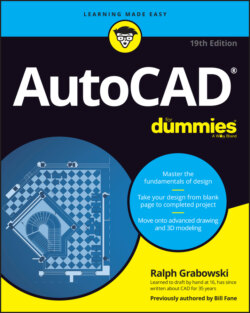Читать книгу AutoCAD For Dummies - Ralph Grabowski - Страница 68
Drawing for Success
ОглавлениеAutoCAD offers a wide range of tools that allow you to create designs in a virtual world that will be accurately manufactured or built in the real world. The 2D and 3D tools that you use require some upfront preparation to ensure that the designs you create are drawn precisely. Nothing is worse than spending time on a great design, only to find out that the objects you drew weren’t drawn at the correct size and that lines don’t intersect cleanly. Okay, I lied. Worse yet is that your imprecise drawing was used to program a CNC machining center or build a house and now the expensive parts don’t fit.
Here are a few important techniques to use when you draw objects:
Use precision tools to make sure objects intersect precisely and are drawn at the correct angle. Precision tools allow you to reference points on existing objects, constrain the cursor to a specific angle or snap distance, and quickly locate a point based on a distance and direction in which the cursor is moved. I cover precision techniques and tools in Chapter 8.
Understand the difference between command line and Dynamic Input coordinate entry. Second and next points entered at the command line are interpreted differently from those entered at the Dynamic Input tooltip. The second and next points entered at the Dynamic Input tooltip are formatted as polar and are relative to the previously entered coordinate value automatically, unlike at the command line where you must first type @ before the coordinate value for relative coordinates. AutoCAD’s Dynamic Input system displays a lot of the information at the cursor that you used to have to look down to the command line to see. To use Dynamic Input, press F12 to toggle it on and off.
Watch the command line. The command line at times displays additional information about the current command that’s not displayed in the Dynamic Input tooltip. This information might be the current text style or justification, or the active extend mode. I cover using the command line in Chapter 2.
Organize objects on layers. All the objects you draw should be placed on specific layers. For example, annotation objects that communicate design information might be placed on a Notes layer, and the lines that are used to represent a wall might be placed on a Walls layer. I cover layers in Chapter 9.
